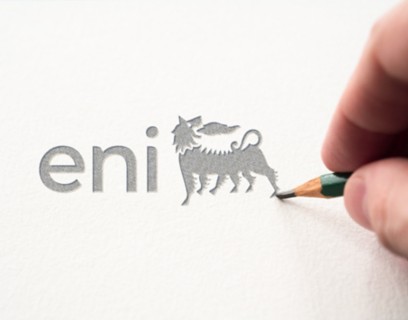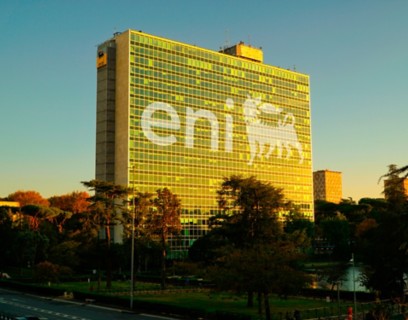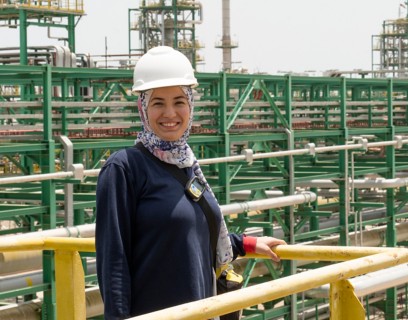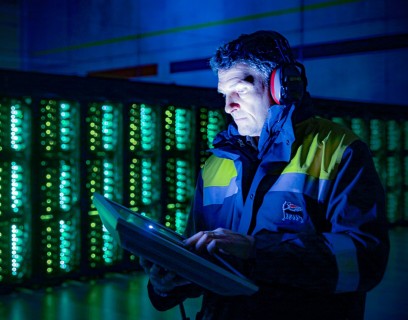- COMPANY
- TECHNOLOGIES AND DEVELOPMENT
Technological innovation at the Gazometro complex in Roma Ostiense
The Gazometro and the surrounding area host workshops, institutional events and initiatives which are open to the public.

Between history and the future
The former Gazometro in Rome is located in the Ostiense neighbourhood and is a symbol of urban industrial archaeology. Today, the area around the "iron giant" is being converted into an innovation and sustainability hub. Eni is carrying out a major rehabilitation of the industrial areas and reclamation works at the site, with the aim of building its largest Technological Innovation District in Rome: ROAD - Rome Advanced District, an open entrepreneurial ecosystem capable of attracting public and private players, a place of creative experimentation for solutions related to the energy transition.
Inside the area there is already Eni 2050 Lab, a permanent exhibition space for Eni's projects and technologies, Joule, Eni's School for Business and the start-up accelerator ZERO - The Clean Tech Accelerator.
Arte al Gazometro 2025 shows the energy of talent
The 2025 season of "Arte al Gazometro" at the Roma Ostiense complex continues its important autumn program, reinforcing the bond between energy and culture. Through a collaboration between Eni and the MAXXI - National Museum of 21st Century Arts, the Ostiense Gazometro will host "More than meets the eye" by Maurizio Nannucci, an artist renowned for his exploration of the relationship between art, language, and image, expressed through iconic neon installations.
The work, conceived in a new arrangement to create a dialogue with the site's architecture, will be on public display until March 26, 2026.
Discover Arte al Gazometro
The 2025 cultural season at the Rome Ostiense site celebrates the link between energy and art with installations, exhibitions, and collaborations.

Technological innovation for the energy transition. Eni’s projects for the area
Eni’s projects for the area.
ROAD - Rome Advanced District: the road to the future
Rome Advanced District project is an open-air laboratory, an ecosystem dedicated to the energy transition that hosts start-ups and innovative projects. It is an area for innovation to develop, experiment and implement technological projects applied to non-emissive energy.
In an area of approximately 13 hectares in the Rome Ostiense district, ROAD is a business network capable of bringing together the public and private sector (corporations, SMEs, institutions, universities, start-ups and research centres) generating a cross-fertilization process with an integrated supply chain perspective. We are working every day to make ROAD an open, inclusive place, a hothouse of talent and a centre of knowledge and advanced research.
Eni 2050 Lab: the new technology research hub
Inside the Complex, and more specifically in one of the twin buildings once dedicated to the production and purification of water gas, is the Eni 2050 Lab, a real technopole, dedicated to the innovative projects and technologies that Eni is developing in its research centres. It is a multi-functional space that also houses an open laboratory with hyper-technological equipment, a monitoring area and an immersive viewing area for advanced modelling based on Eni’s HPC4 and HPC5 supercomputers.
Inside, visitors can see some of Eni's technologies and products for decarbonization, including:
- bioadvanced fuels produced by agri-feedstock and waste&residue supply chains
- technologies from the CCUS (Carbon Capture Utilization & Storage) chain for the capture, utilization and storage of CO2
- some technologies for environmental restoration (e-Hyrec and phytoremediation) and a powerful model of magnetic confinement fusion.
Joule, the Eni business school
The Gazometro is also home to Joule, Eni's School for Business, which aims to support the growth of sustainable enterprises, training a new generation of male and female entrepreneurs through the development of skills and the use of key tools to accelerate start-ups. Joule contributes to providing access to specific challenges and opportunities, provides a network of excellent trainers and lecturers, and creates the conditions to become part of a great community. A true ecosystem where new visions of the future are given space.
ZERO - The Clean Tech Accelerator
Through Joule and CDP Venture, Acea, Vodafone, Maire Tecnimont and Microsoft, with the support of LVenture and the Elis Consortium, Eni has set up ZERO, the Italian cleantech accelerator of the Cassa Depositi e Prestiti (CDP) National Accelerator Network, with the aim of fostering the birth of sustainable enterprises throughout the country, promoting and nurturing partnerships and collaborations with universities, accelerators and stakeholders.
The Agi (Agenzia Giornalistica Italia) headquarters
Near Piazza del Gazometro, just a few metres from the massive facility and from the Bridge of Science, is the editorial office of Agi (Agenzia Giornalistica Italia). After its foundation in 1950, the news agency was sold to Eni, with which it was already collaborating, in 1965. Today, Agi continues to follow its editorial line based on internationalization, which it began to pursue in the mid-1970s through a strategy of partnerships with news organizations located in emerging countries and in areas of great geopolitical interest.
Technological innovation for the energy transition. Eni’s projects for the area
Eni’s projects for the area.
ROAD
ROAD - Rome Advanced District: the road to the future
Rome Advanced District project is an open-air laboratory, an ecosystem dedicated to the energy transition that hosts start-ups and innovative projects. It is an area for innovation to develop, experiment and implement technological projects applied to non-emissive energy.
In an area of approximately 13 hectares in the Rome Ostiense district, ROAD is a business network capable of bringing together the public and private sector (corporations, SMEs, institutions, universities, start-ups and research centres) generating a cross-fertilization process with an integrated supply chain perspective. We are working every day to make ROAD an open, inclusive place, a hothouse of talent and a centre of knowledge and advanced research.
Eni 2050 Lab
Eni 2050 Lab: the new technology research hub
Inside the Complex, and more specifically in one of the twin buildings once dedicated to the production and purification of water gas, is the Eni 2050 Lab, a real technopole, dedicated to the innovative projects and technologies that Eni is developing in its research centres. It is a multi-functional space that also houses an open laboratory with hyper-technological equipment, a monitoring area and an immersive viewing area for advanced modelling based on Eni’s HPC4 and HPC5 supercomputers.
Inside, visitors can see some of Eni's technologies and products for decarbonization, including:
- bioadvanced fuels produced by agri-feedstock and waste&residue supply chains
- technologies from the CCUS (Carbon Capture Utilization & Storage) chain for the capture, utilization and storage of CO2
- some technologies for environmental restoration (e-Hyrec and phytoremediation) and a powerful model of magnetic confinement fusion.
Joule
Joule, the Eni business school
The Gazometro is also home to Joule, Eni's School for Business, which aims to support the growth of sustainable enterprises, training a new generation of male and female entrepreneurs through the development of skills and the use of key tools to accelerate start-ups. Joule contributes to providing access to specific challenges and opportunities, provides a network of excellent trainers and lecturers, and creates the conditions to become part of a great community. A true ecosystem where new visions of the future are given space.
ZERO
ZERO - The Clean Tech Accelerator
Through Joule and CDP Venture, Acea, Vodafone, Maire Tecnimont and Microsoft, with the support of LVenture and the Elis Consortium, Eni has set up ZERO, the Italian cleantech accelerator of the Cassa Depositi e Prestiti (CDP) National Accelerator Network, with the aim of fostering the birth of sustainable enterprises throughout the country, promoting and nurturing partnerships and collaborations with universities, accelerators and stakeholders.
AGI
The Agi (Agenzia Giornalistica Italia) headquarters
Near Piazza del Gazometro, just a few metres from the massive facility and from the Bridge of Science, is the editorial office of Agi (Agenzia Giornalistica Italia). After its foundation in 1950, the news agency was sold to Eni, with which it was already collaborating, in 1965. Today, Agi continues to follow its editorial line based on internationalization, which it began to pursue in the mid-1970s through a strategy of partnerships with news organizations located in emerging countries and in areas of great geopolitical interest.
The complex’s history
The photographic book titled "The Iron Giant" narrates the present, past and future of this landmark of the city of Rome. In three excerpts from the book, you can learn about the origins of the area and the advent of modernity in the words of writer and journalist Corrado Augias, explore the rise and fall of the industrial area of the Gazometro in an article by Maristella Casciato, professor of History of Architecture at Bologna University and discover its role as a symbol of the city and preferred location for Roman cinema in an essay by film historian Sergio Toffetti.
Three excerpts from the book “Il colosso di ferro. Lighting, industry and modernity. Breve storia del colosso di ferro” (The Iron Giant. A brief history of the Iron Giant).
Chronology of Gazometro Ostiense complex
From the first bricks to forays into the world of cinema and the repurposing of the area.
Between 1910 and 1912, thanks to mayor Ernesto Nathan, the first three gasometers with a total capacity of 110,000 cubic metres of gas came into operation.
The great iron giant, which became known as the Rome Gazometro, was built by Ansaldo and was at the time the largest in Europe with a capacity of 200,000 cubic metres.
The complex was used to supply gas to the city and served as a backdrop for iconic films such as "Four steps in the cloud" (1942), "Umberto D" (1952) and "Sunday in August" (1950).
The methanization of the city began. From being the beating heart that ensured the life of countless businesses, the gas factory became a symbol of an obsolete industrial process.
A large number of statues were moved from the Capitoline Museums to the former Montemartini power plant, opening the door to the redevelopment of the area as a cultural centre.
Almost along the same axis as the gasometer, the Ponte della Scienza (Bridge of Science), a pedestrian and bicycle bridge, was opened, giving new life and a modern access to the area.
Eni reclaimed the area in the Ostiense neighbourhood to start a process of redevelopment in line with the site's original purpose, i.e. a mix of energy and innovation.
Eni hosted the tenth edition of the innovation event Maker Faire in the area of the former Gazometro in Ostiense. The occasion marked the opening of the Eni 2050 lab.
Don't miss a single update
Sign up to our newsletter and activate your e-mail alert to discover the insights from the world of Eni
























